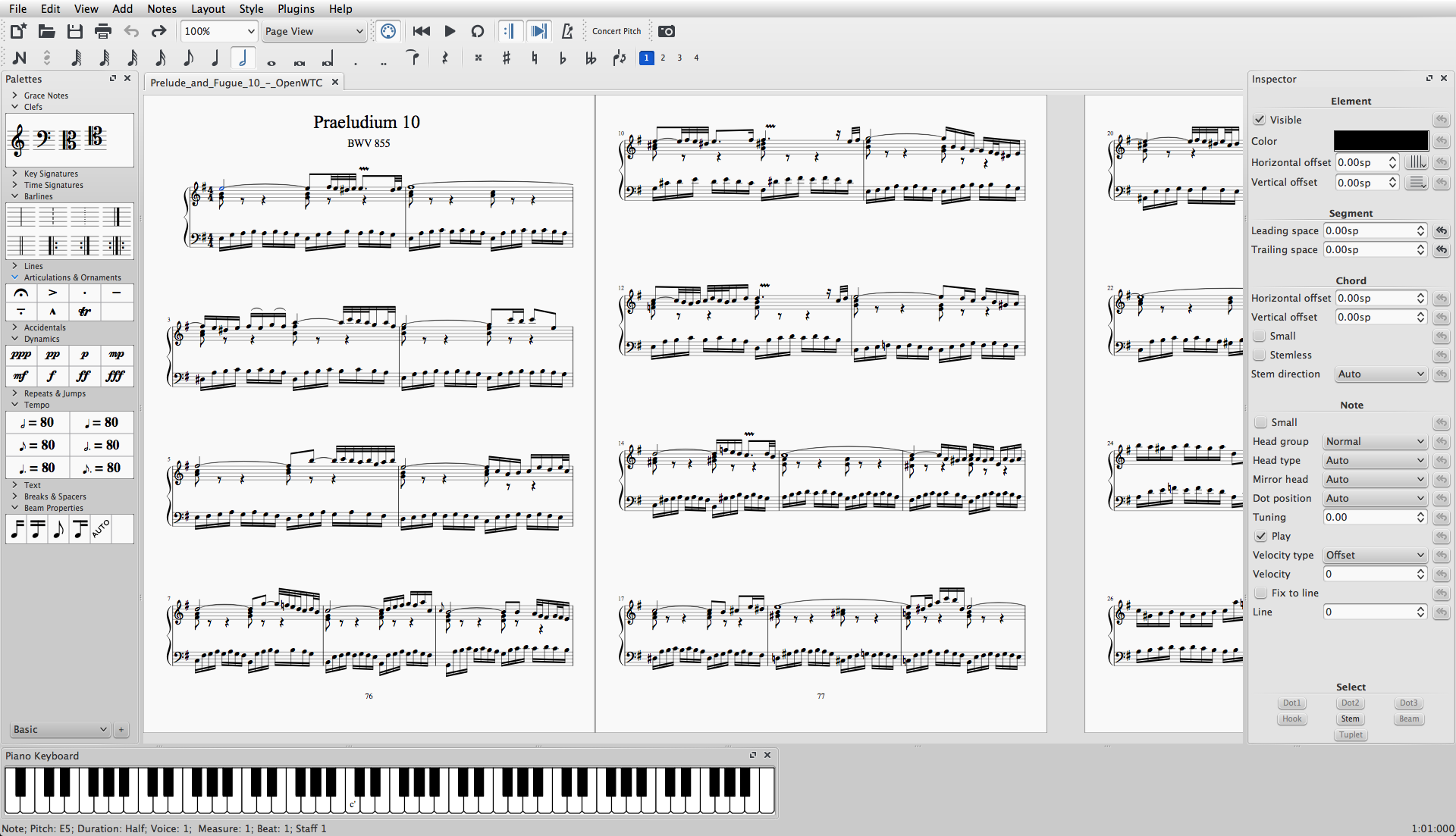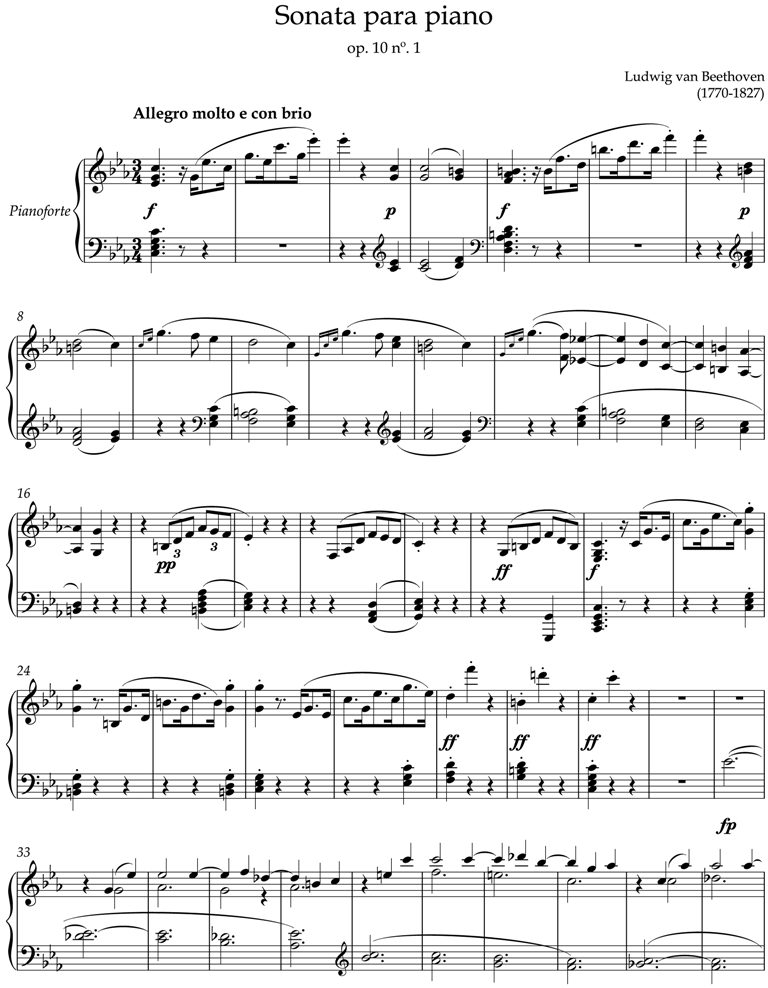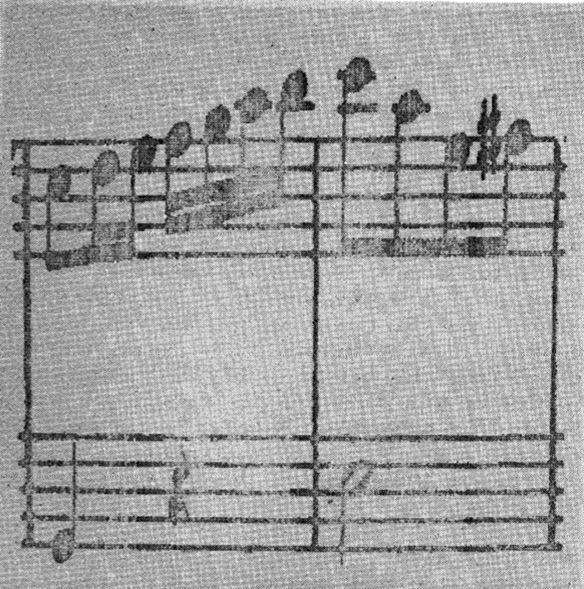|
Scorewriter
A scorewriter, or music notation program is software for creating, editing and printing sheet music. A scorewriter is to music notation what a word processor is to text, in that they typically provide flexible editing and automatic layout, and produce high-quality printed results. Most scorewriters, especially those from the 2000s, can record notes played on a MIDI keyboard (or other MIDI instruments), and play music back via MIDI or virtual instruments. Playback is especially useful for novice composers and music students, and when musicians are not available or affordable. Several free programs are widely used, such as MuseScore. The three main professional-level programs are Finale, Sibelius and Dorico. Comparison with multitrack sequencer software Multitrack sequencer software and scorewriters typically employ different methods for notation input and display. Scorewriters are based on traditional music notation, using staff lines and round note heads, which originate ... [...More Info...] [...Related Items...] OR: [Wikipedia] [Google] [Baidu] |
Sibelius (scorewriter)
Sibelius is a scorewriter program developed and released by Sibelius Software Limited (now part of Avid Technology). It is the world's largest selling music notation program. Beyond creating, editing and printing music scores, Sibelius can also play the music back using sampled or synthesised sounds. It produces printed scores, and can also publish them via the Internet for others to access. Less advanced versions of Sibelius at lower prices have been released, as have various add-ons for the software. Named after the Finnish composer Jean Sibelius, the company was founded in April 1993 by twin brothers Ben and Jonathan Finn to market the eponymous music notation program they had created. It went on to develop and distribute various other music software products, particularly for education. In addition to its head office in Cambridge and subsequently London, Sibelius Software opened offices in the US, Australia and Japan, with distributors and dealers in many other coun ... [...More Info...] [...Related Items...] OR: [Wikipedia] [Google] [Baidu] |
Dorico
Dorico () is a scorewriter software; along with Finale and Sibelius, it is one of the three leading professional-level music notation programs. Dorico's development team consists of most of the former core developers of a rival software, Sibelius. After the developers of Sibelius were laid off in a 2012 restructuring by their corporate owner, Avid, most of the team were re-hired by a competing company, Steinberg, to create a new software. They aimed to build a "next-generation" music notation program, and released Dorico four years later, in 2016. History The project was unveiled on 20 February 2013 by the Product Marketing Manager, Daniel Spreadbury, on the blog ''Making Notes'', and the software was first released on 19 October 2016. The program's title ''Dorico'' was revealed on the same blog on 17 May 2016. The name honours the 16th-century Italian music engraver Valerio Dorico (1500 – c. 1565), who printed first editions of sacred music by Giovanni Pierluigi da Pa ... [...More Info...] [...Related Items...] OR: [Wikipedia] [Google] [Baidu] |
Sheet Music
Sheet music is a handwritten or printed form of musical notation that uses musical symbols to indicate the pitches, rhythms, or chords of a song or instrumental musical piece. Like its analogs – printed books or pamphlets in English, Arabic, or other languages – the medium of sheet music typically is paper (or, in earlier centuries, papyrus or parchment). However, access to musical notation since the 1980s has included the presentation of musical notation on computer screens and the development of scorewriter computer programs that can notate a song or piece electronically, and, in some cases, "play back" the notated music using a synthesizer or virtual instruments. The use of the term "sheet" is intended to differentiate written or printed forms of music from sound recordings (on vinyl record, cassette, CD), radio or TV broadcasts or recorded live performances, which may capture film or video footage of the performance as well as the audio component. In every ... [...More Info...] [...Related Items...] OR: [Wikipedia] [Google] [Baidu] |
SCORE (software)
SCORE is a scorewriter program, written in FORTRAN for MS-DOS by Stanford University Professor Leland Smith (1925–2013) with a reputation for producing very high-quality results. It was widely used in engraving during the 1980s and 1990s and continues to have a small, dedicated following of engravers, many of whom hold the program in high regard due to its ability to position symbols precisely on the page. Several publications set using SCORE have earned Paul Revere and German Musikpresse engraving awards. Program development Mainframe origins The first incarnation of SCORE was written by Leland Smith in 1967 as a means of entering music into the MUSIC V sound generating system running on the PDP-10 mainframe computers at the Stanford Artificial Intelligence Laboratory (SAIL). The core concept of SCORE was to break music into a set of items ('objects' in modern terminology) with parameters that describe their characteristics. In this example of an early SCORE routine the ... [...More Info...] [...Related Items...] OR: [Wikipedia] [Google] [Baidu] |
Finale (software)
Finale is a proprietary music notation software developed and released by MakeMusic for Microsoft Windows and macOS since 1988. Functionality Finale's tools are organized into multiple hierarchically organized palettes, and the corresponding tool must be selected to add or edit any particular class of score element. Voices are available in Finale as well. Several of Finale's tools provide an associated menu just to the left of the Help menu, available only when that particular tool is selected. In general, operation of Finale bears at least some surface similarities to Adobe Photoshop. On the screen, Finale provides the ability to color code several elements of the score as a visual aid; on the print-out all score elements are black (unless color print-out is explicitly chosen). With the corresponding tool selected, fine adjustment of each set of objects in a score are possible either by clicking and dragging or by entering measurements in a dialog box. A more generalized sele ... [...More Info...] [...Related Items...] OR: [Wikipedia] [Google] [Baidu] |
Capella (notation Program)
capella is a musical notation program or scorewriter developed by the German company ''Capella Software AG'' (formerly WHC), running on Microsoft Windows or corresponding emulators in other operating systems, like Wine on Linux and others on Apple Macintosh. Capella requires to be activated after a trial period of 30 days. The publisher writes the name in lower case letters only. The program was initially created by Hartmut Ring, and is now maintained and developed by Bernd Jungmann. Capella is one of the earliest computer programs for music notation and has a relatively moderate price compared with Finale or Sibelius, though up to version 7 it ran only on Windows. Capella claims to have 300,000 users for the music notation program and 120,000 for the OCR program. Digital sheet music in capella formats is available in various online music libraries, especially in German speaking areas. The German Protestant hymnal ' has been digitized using capella software. Originally a ... [...More Info...] [...Related Items...] OR: [Wikipedia] [Google] [Baidu] |
Music Notation
Music is generally defined as the art of arranging sound to create some combination of form, harmony, melody, rhythm or otherwise expressive content. Exact definitions of music vary considerably around the world, though it is an aspect of all human societies, a cultural universal. While scholars agree that music is defined by a few specific elements, there is no consensus on their precise definitions. The creation of music is commonly divided into musical composition, musical improvisation, and musical performance, though the topic itself extends into academic disciplines, criticism, philosophy, and psychology. Music may be performed or improvised using a vast range of instruments, including the human voice. In some musical contexts, a performance or composition may be to some extent improvised. For instance, in Hindustani classical music, the performer plays spontaneously while following a partially defined structure and using characteristic motifs. In modal jazz t ... [...More Info...] [...Related Items...] OR: [Wikipedia] [Google] [Baidu] |
MIDI
MIDI (; Musical Instrument Digital Interface) is a technical standard that describes a communications protocol, digital interface, and electrical connectors that connect a wide variety of electronic musical instruments, computers, and related audio devices for playing, editing, and recording music. The specification originates in the paper ''Universal Synthesizer Interface'' published by Dave Smith and Chet Wood of Sequential Circuits at the 1981 Audio Engineering Society conference in New York City. A single MIDI cable can carry up to sixteen channels of MIDI data, each of which can be routed to a separate device. Each interaction with a key, button, knob or slider is converted into a MIDI event, which specifies musical instructions, such as a note's pitch, timing and loudness. One common MIDI application is to play a MIDI keyboard or other controller and use it to trigger a digital sound module (which contains synthesized musical sounds) to generate sounds, wh ... [...More Info...] [...Related Items...] OR: [Wikipedia] [Google] [Baidu] |
Music OCR
Optical music recognition (OMR) is a field of research that investigates how to computationally read musical notation in documents. The goal of OMR is to teach the computer to read and interpret sheet music and produce a machine-readable version of the written music score. Once captured digitally, the music can be saved in commonly used file formats, e.g. MIDI (for playback) and MusicXML (for page layout). In the past it has, misleadingly, also been called "music optical character recognition". Due to significant differences, this term should no longer be used. History Optical music recognition of printed sheet music started in the late 1960s at the Massachusetts Institute of Technology when the first image scanners became affordable for research institutes. Due to the limited memory of early computers, the first attempts were limited to only a few measures of music. In 1984, a Japanese research group from Waseda University developed a specialized robot, called WABOT (WAseda roBOT ... [...More Info...] [...Related Items...] OR: [Wikipedia] [Google] [Baidu] |
Music Engraving
Music engraving is the art of drawing music notation at high quality for the purpose of mechanical reproduction. The term ''music copying'' is almost equivalent—though ''music engraving'' implies a higher degree of skill and quality, usually for publication. The name of the process originates in plate engraving, a widely used technique dating from the late sixteenth century. The term ''engraving'' is now used to refer to any high-quality method of drawing music notation, particularly on a computer ("computer engraving" or "computer setting") or by hand ("hand engraving"). Traditional engraving techniques Elements of music engraving style Mechanical music engraving began in the middle of the fifteenth century. As musical composition increased in complexity, so too did the technology required to produce accurate musical scores. Unlike literary printing, which mainly contains printed words, music engraving communicates several different types of information simultaneous ... [...More Info...] [...Related Items...] OR: [Wikipedia] [Google] [Baidu] |
Steinberg
Steinberg Media Technologies GmbH (trading as Steinberg) is a German musical software and hardware company based in Hamburg. It develops music writing, recording, arranging, and editing software, most notably Cubase, Nuendo, and Dorico. It also designs audio and MIDI hardware interfaces, controllers, and iOS/ Android music apps including Cubasis. Steinberg created several industry standard music technologies including the Virtual Studio Technology (VST) format for plug-ins and the ASIO (Audio Stream Input/Output) protocol. Steinberg has been a wholly owned subsidiary of Yamaha since 2005. History The company was founded in 1984 by Karl Steinberg and Manfred Rürup in Hamburg. As early proponents and fans of the MIDI protocol, the two developed Pro 16, a MIDI sequencing application for the Commodore 64 and soon afterwards, Pro 24 for the Atari ST platform. The ST had built-in MIDI ports which helped to quickly increase interest in the new technology across the music world. ... [...More Info...] [...Related Items...] OR: [Wikipedia] [Google] [Baidu] |





